The Google Pixel C Review
by Brandon Chester & Joshua Ho on January 25, 2016 8:00 AM ESTDisplay Analysis
At the launch event for their new Nexus phones and the Pixel C, Google made a point of advertising the Pixel C’s display as a 2560x1800 panel with a 500nit brightness, a 1.422 aspect ratio, and a low-temperature polycrystalline silicon (LTPS) backplane. The use of LTPS doesn’t have a direct impact on the user as far as display accuracy is concerned, but it can help to lower power usage and increase brightness by reducing the size of light-blocking circuitry. This can also lead to longer battery life by reducing display power, as the backlights don’t need to be pushed to as high of a brightness.
The Pixel C’s aspect ratio is a very interesting choice. While one can consider the 4:3 aspect ratio of the iPad to be fairly close to a digitized sheet of 11 x 8.5” paper, the fact that most of the world uses A series paper which has a square root of two 2 aspect ratio makes the Pixel C especially well-suited for displaying those documents. It’s a wider aspect ratio than what you get with a 4:3 display, but not as wide as the one on a 16:10 Android tablet, and slightly less wide than Microsoft’s Surface Tablets which have a 3:2 aspect ratio. However, the Pixel C is still wide enough that you’re clearly intended to use it in a landscape orientation. Landscape doesn’t lend itself well to the majority of Android apps that just throw up a big phone UI and call it a day, and I feel that it may have been a mistake on Google’s part. A future update to enable split-screen multitasking may change things here, but for now you’re stuck with an interface and applications that just don’t feel at home on a display of these proportions.
Something that I felt worth noting about the Pixel C was how reflective the glass appears to be. While we don’t have a test for the exact reflectivity of a display, it’s something that can be fairly well gauged just by using the device and making comparative observations to other devices. All of the Android tablets I review are clearly more reflective than the latest iPads due to the lack of anti-reflective coatings, but the Pixel C really stands out for its high reflectance. I’ve had a number of issues using the Pixel C due to reflections making it impossible to see what’s on the screen, which means that I have to increase the brightness to compensate. This subsequently reduces the battery life because it increases the power consumed by the display. While Google is able to overcome these issues due to their high brightness, utilizing an anti-reflective coating to allow for visibility even with a low brightness allows for better real-world battery life.
In addition to fairly basic specifications like brightness, resolution, and aspect ratio, a display has many other aspects relating to color accuracy. On mobile platforms, a display must target the sRGB color standard to accurately render the content that one will find on the web, and through all video streaming and photo sharing services. To evaluate a display’s accuracy relative to the sRGB standard we run it through our custom display workflow, using an X-Rite i1Pro 2 spectrophotometer and i1Display Pro colorimeter along with SpectraCal’s CalMAN 5 software for collecting and managing the data.

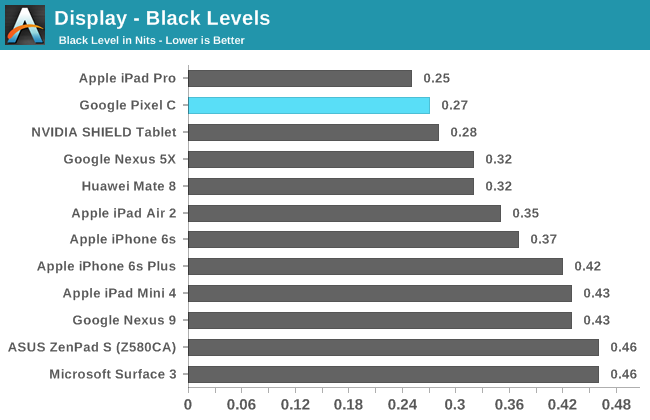
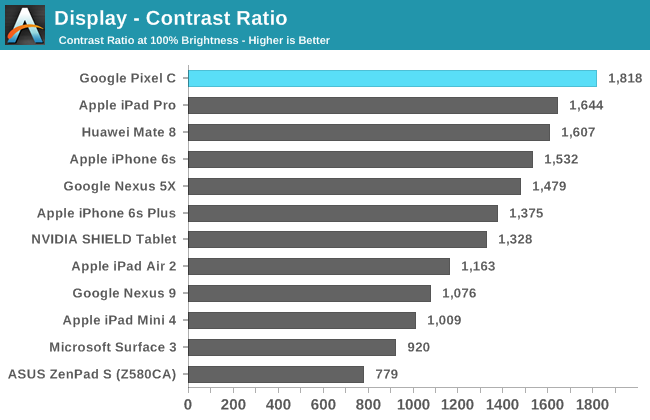
The Pixel C’s display goes up to 495 nits measured at the center of the display, and so Google was quite accurate in their advertisement of 500nits. This is the brightest tablet on record, beating the Nexus 9 by around 25 nits. As I mentioned earlier, the highly reflective glass makes the high brightness levels quite necessary, which will likely end up impacting the real-world battery life that Pixel C owners see. It’s also worth noting that the touch sensor layer is highly visible when light shines on the display, which makes it even more difficult to use outdoors or with overhead lighting. This is something that I’ve only seen managed well on Samsung and Apple devices, and for a flagship Android tablet with a completely custom display I expect better in this regard than what the Pixel C delivers.
In addition to the high brightness, the Pixel C has quite deep black levels for an LCD tablet. With a black level of 0.2718 nits and a contrast ratio of 1818 at max brightness, the Pixel C has the best contrast of any tablet that we’ve seen to date, besting even the iPad Pro.
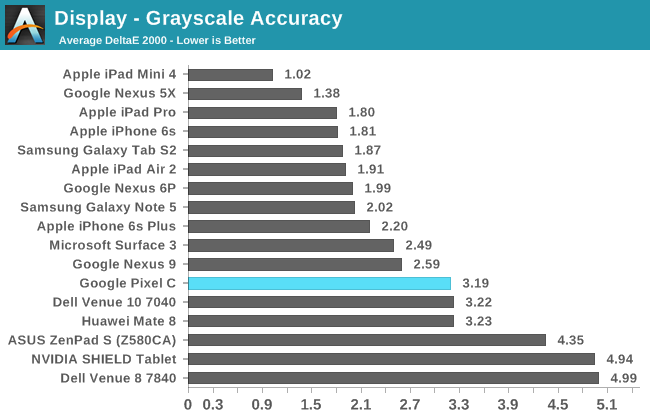
Greyscale accuracy on the Pixel C is fairly good, with a DeltaE error value slightly over the motion-visible value of 3. The error is mostly due to the green component of luminance dropping as you move from black to white. While we certainly have been spoiled by the rapid increase in mobile display quality over the last few years, I do think that Google could have pushed color accuracy higher here. That isn’t to say that I think the Pixel C will disappoint, but considering that it’s an entirely custom panel on a premium device that won’t be shipping in high volume, I think Google could have gone a bit further. Competition is getting fairly fierce in this category, with devices pushing for DeltaE values below 2, and some units achieving values below 1 which would make the error impossible for the eye to detect in any circumstance. In the end, the Pixel C’s greyscale accuracy is quite good, but it’s not the absolute best that I’ve seen.

The Pixel C’s accuracy with rendering primary and secondary color saturations is excellent. With an average DeltaE value below 2, I doubt any person will find themselves bothered by what little inaccuracy there is. The only color that actually exhibits an error above 3 is 100% red, with the remaining values all sitting below.
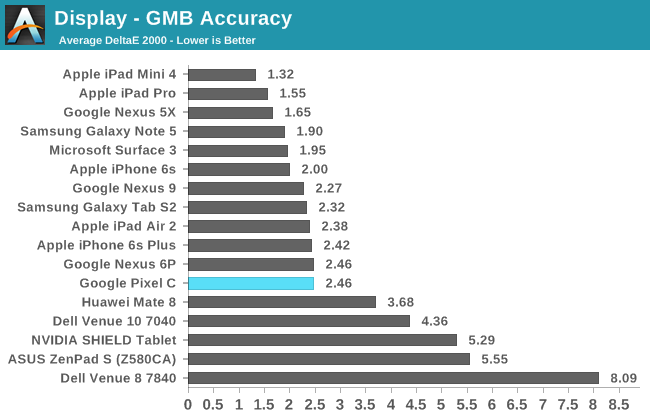
The Pixel C does quite well in the Gretag-MacBeth ColorChecker test. The average error is below 3, with the only outliers being color mixtures that primarily have a blue component, along with the greyscale values that are included in the test. Most other colors have DeltaE values somewhere between 1 and 2, and with that kind of accuracy I don’t really have any complaints, even if it’s not the absolute best result that I’ve ever seen.
In the end, the Pixel C comes with a bright, accurate, and high resolution display, with one of the highest contrast ratios that I’ve seen on a tablet. Google could definitely improve greyscale performance a little, and all companies need to start applying the same sort of anti-reflective coatings that Apple applies to their iPads, because the difference in outdoor usability is dramatic when you compare them. The Pixel C’s high reflectivity has been a noticeable obstacle when using it in environments that have overhead lighting, which includes my own home. That kind of little detail is the sort of thing that, when properly recognized and addressed, can really take a product to the next level. As it is, the Pixel C’s display is very good in many respects, but among high end tablets it’s not one I can call the absolute best.



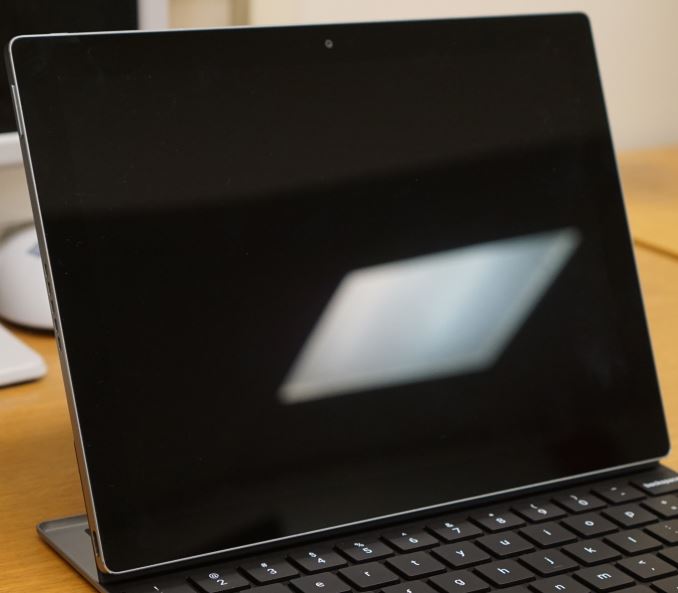
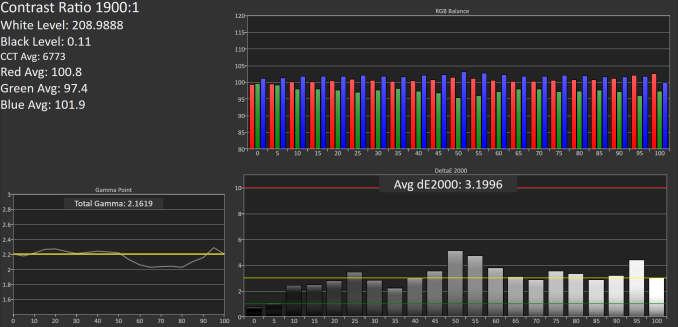

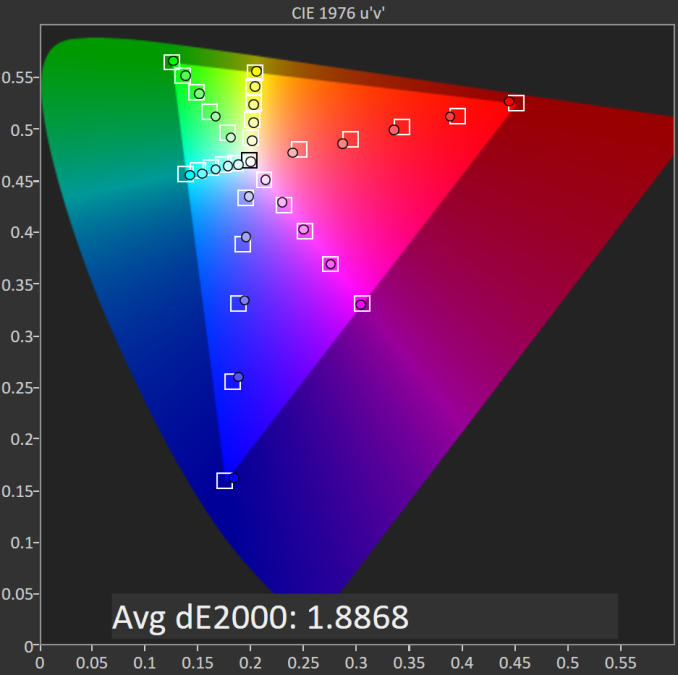









122 Comments
View All Comments
tipoo - Monday, January 25, 2016 - link
Ars theorized that this was never meant to run Android...Reading this review, it seems to add some plausibility to that.http://arstechnica.com/gadgets/2015/12/the-pixel-c...
tipoo - Monday, January 25, 2016 - link
Not that ChromeOS would really help on the app front, so Google is in a bit of a pickle.testbug00 - Tuesday, January 26, 2016 - link
ChromeOS would help a lot on the multitasking and functionality front. Think of it as a high end chromebook that has the ability to be used as a tablet.marcryan - Monday, January 25, 2016 - link
I just finished returning my Pixel C. I didn't have issues in connecting the device and keyboard nor did I have problems with Internet connectivity. But the major show stopper for me was the touch screen latency. It was insane how many times I had to touch the device to get it to respond. I even tried a stylus on the screen in a drawing program and the pixel was unable to track a straight line without breaks along the way where the screen did not register the input.Beyond that there was a supreme amount of waiting time for an app to respond after tapping on it on the home screen. I did a side by side with my Nexus 6P and the nexus (not without its own flaws) performed noticeably faster which is shocking considering the benchmark scores on the pixel C processor.
There's something fatally flawed in the device which is unfortunate because I really wanted to like it, it's a nice piece of hardware.
evefavretto - Monday, January 25, 2016 - link
Another interesting characteristic of the A-series, and by extension, Pixel C' screen is the fact that, once divided in half, the two remaining parts keep the same proportion: 1:√2.Probably a design choice for a multitasking feature that was scrapped from Chrome OS and now will see the light of the day in Android.
Dribble - Monday, January 25, 2016 - link
Thank you for the NAND performance charts - I have been bitten twice by cheap and nasty NAND killing my tablet's performance after a year or two. I now won't touch one unless I know it's NAND is decent - and pixel C really is pretty borderline considering how high end it's meant to be.Agree google has software problems, although I would say it goes beyond missing features. It's clearly far to hard to keep something working as you upgrade. Almost every device I have owned has worked best on whatever version of android it came with. Every upgrade generally introduces problems. I get the feeling they developed the pixel c with android 5 and I bet it worked fine there, then they did an upgrade too 6 and now have all manor of niggles to sort out. Hence I am actually more drawn to devices that don't have major android version upgrades. I'll take an out of date but working version of android over the latest and greatest but slightly broken every time.
Dobson123 - Monday, January 25, 2016 - link
There is a mistake in the chart on the first page: The Tegra K1 has 192 shader units, not 128.And do you know why they have disabled the A53 cores?
Kepe - Monday, January 25, 2016 - link
Judging by the overall unfinishedness of the Pixel C, I'd guess migrating from the small cores to the big ones and vice versa causes some kind of a performance issue Google couldn't solve, as the Tegra X1 doesn't have heterogenous multi-processing.. So there'd be even more lag and performance issues than there is now.But perhaps it doesn't really even matter, since the big cores go as low as 51 MHz. It probably wouldn't save much power (if at all) if the little cores were used when there's a low workload. Battery performance seems to be really good even without the little cores.
Brandon Chester - Monday, January 25, 2016 - link
Indeed you are right. I've corrected the error.As for the cluster migration, just keep in mind that the SHIELD TV doesn't do it either. Granted, that is plugged into the wall so power isn't a big deal, but it's important to note that we haven't see a single implementation where the A53s are used so I wouldn't be quick to blame it on the Pixel C specifically.
tipoo - Monday, January 25, 2016 - link
For the SHIELD does it not do switching, or does it turn the A53s off completely? As something plugged into a wall and with overkill cooling for an ARM SoC, it may as well use all 8 all the time, no?